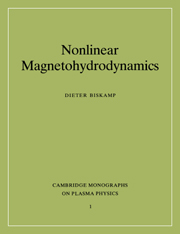Book contents
- Frontmatter
- Contents
- Preface
- 1 Introduction
- 2 Basic properties of magnetohydrodynamics
- 3 Magnetostatic equilibria
- 4 Normal modes and instability
- 5 Nonlinear evolution of MHD instabilities
- 6 Magnetic reconnection
- 7 MHD turbulence
- 8 Disruptive processes in tokamak plasmas
- 9 Dynamics of the reversed-field pinch
- 10 Solar flares
- Outlook
- References
- Index
6 - Magnetic reconnection
Published online by Cambridge University Press: 15 December 2009
- Frontmatter
- Contents
- Preface
- 1 Introduction
- 2 Basic properties of magnetohydrodynamics
- 3 Magnetostatic equilibria
- 4 Normal modes and instability
- 5 Nonlinear evolution of MHD instabilities
- 6 Magnetic reconnection
- 7 MHD turbulence
- 8 Disruptive processes in tokamak plasmas
- 9 Dynamics of the reversed-field pinch
- 10 Solar flares
- Outlook
- References
- Index
Summary
There is hardly a term in plasma physics exhibiting more scents, facets and also ambiguities than does magnetic reconnection or, simply, reconnection. It is even sometimes used with a touch of magic. The basic picture underlying the idea of reconnection is that of two field lines (thin flux tubes, properly speaking) being carried along with the fluid owing to the property of flux conservation until they come close together at some point, where by the effect of finite resistivity they are cut and reconnected in a different way. Though this is a localized process, it may fundamentally change the global field line connection as indicated in Fig. 6.1, permitting fluid motions which would be inhibited in the absence of such local decoupling of fluid and magnetic field. Almost all nonlinear processes in magnetized conducting fluids involve reconnection, which may be called the essence of nonlinear MHD.
Because of the omnipresence of finite resistivity in real systems resistive diffusion takes place everywhere in the plasma, though usually at a slow rate. Reconnection theory is concerned with the problem of fast reconnection in order to explain how in certain dynamic processes very small values of the resistivity allow the rapid release of a large amount of free magnetic energy, as observed for instance in tokamak disruptions or solar flares.
- Type
- Chapter
- Information
- Nonlinear Magnetohydrodynamics , pp. 127 - 174Publisher: Cambridge University PressPrint publication year: 1993
- 2
- Cited by



